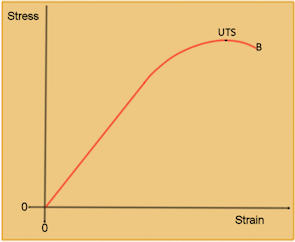
Stress and strainStressForces on a component, e.g. A bar, are often referred to as loads. For example if the cross sectional area is doubled then the load that the component can withstand will be doubled. Hence σ = F Example 1: A rectangular bar of dimensions 5mm breadth x 20 mm depth, supports a load of 4900 N. Determine the stress in the bar. Known values Ultimate tenisle strength and breaking stressA stress large enough to break the material is known as the breaking stess.
Stress is literally pulling apart the material material on an atomic scale which is why the material eventually breaks apart completely if enough stress is applied. This breaking point is labelled as B in the graph above and UTS or the ultimate tensile strength shown on the graph is just that, the maximum stress that the material can withstand, these are very important factors to consider when designing. StrainIn addition to controlling the stress produced in a component, the dimensional changes also require consideration. Hence Note strain does not have any units. Example 2: A wire of length 2 m, extends by 0.25 mm when acted upon by a tensile force. Determine the strain in the wire. From ε
= x ε = 0.25 = 1.25 x 10¯⁴
< < < Back : |
